NCERT Class 6 Science Chapter 15 Air Around Us Solutions to each chapter is provided in the list so that you can easily browse through different chapters NCERT Class 6 Science Chapter 15 Air Around Us and select need one. NCERT Class 6 Science Chapter 15 Air Around Us Question Answers Download PDF. NCERT Class 6 Science Solutions.
NCERT Class 6 Science Chapter 15 Air Around Us
Also, you can read the NCERT book online in these sections Solutions by Expert Teachers as per Central Board of Secondary Education (CBSE) Book guidelines. CBSE Class 6 Science Solutions are part of All Subject Solutions. Here we have given NCERT Class 6 Science Chapter 15 Air Around Us and Textbook for All Chapters, You can practice these here.
Air Around Us
Chapter: 15
NCERT TEXT BOOK EXERCISES
Q. 1. What is the composition of air?
Ans: The major components of air are:
(i) Nitrogen (78%)
(ii) Oxygen (21%)
(iii) Noble gases (0.9%)
(iv) Carbon dioxide (0-0.3%)
(v) Other gases, dust particles and water vapours (0.01%) by volume.
Q. 2. Which gas in the atmosphere is essential for respiration?
Ans: Oxygen gas in the atmosphere is essential for respiration.
Q. 3. How will you prove that air supports burning?
Ans: Take two plastic bottles and remove their base with the help of a sharp knife. Take two candles and cover these two burning candles with the plastic bottles. After some time, candles top burning and water level rises up in the plastic bottles.
Now make several holes in one plastic bottle and cover the lighting candle with this bottle. We see that candle burns continuously. This candle gets air from different holes and burns continuously till it is completely finished.
This activity shows that air supports burning.
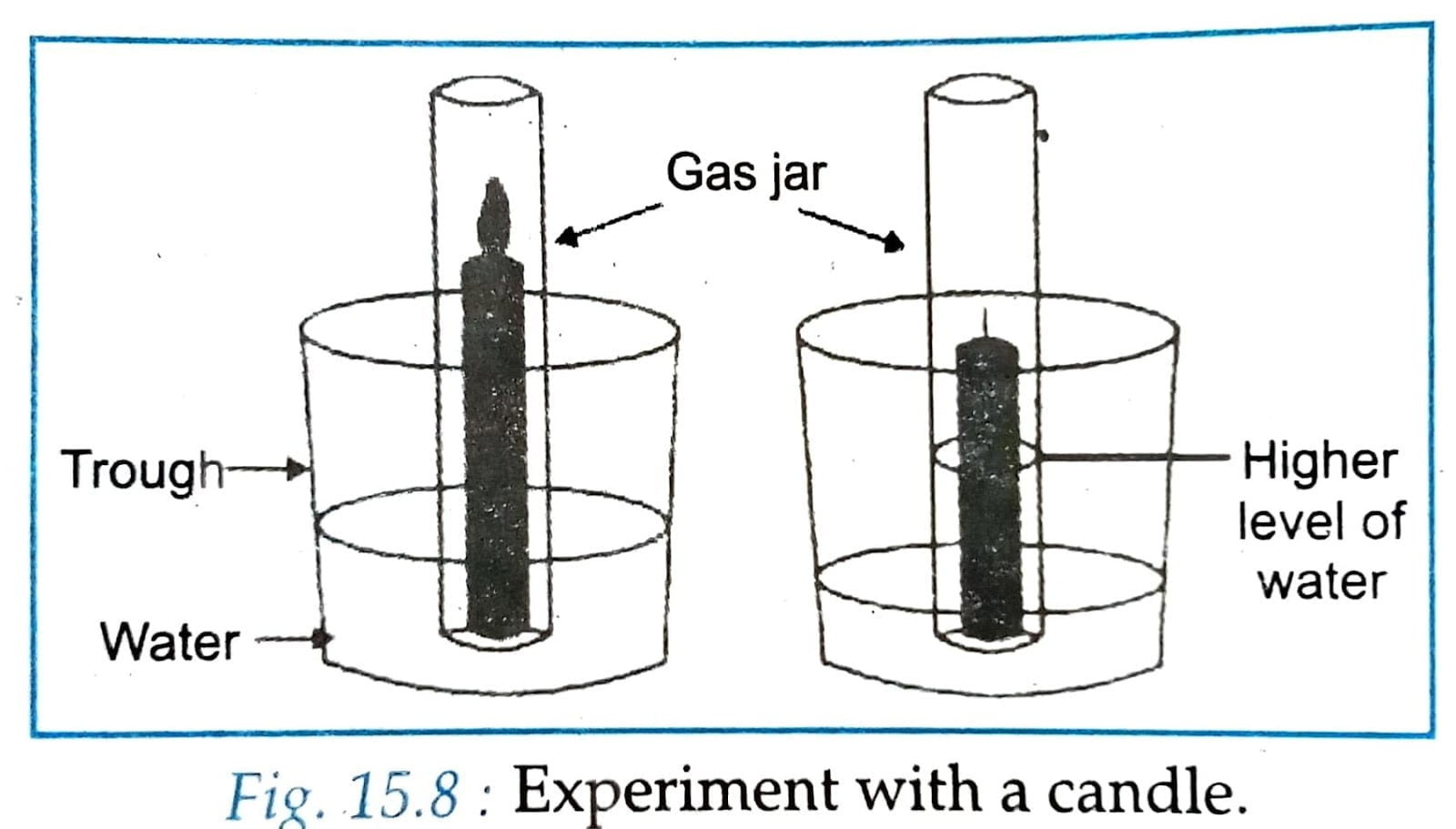
Q. 4. How will you show that air is dissolved in water?
Ans: Take some water in a beaker and heat it slowly on a tripod stand with g burner. We see that tiny bubbles are s on it. These bubbles are mainly of c gas present air, which is dissolved in water, When we heat water, the air dissolved in water escapes out in the form of bubbles. sticking oxygen
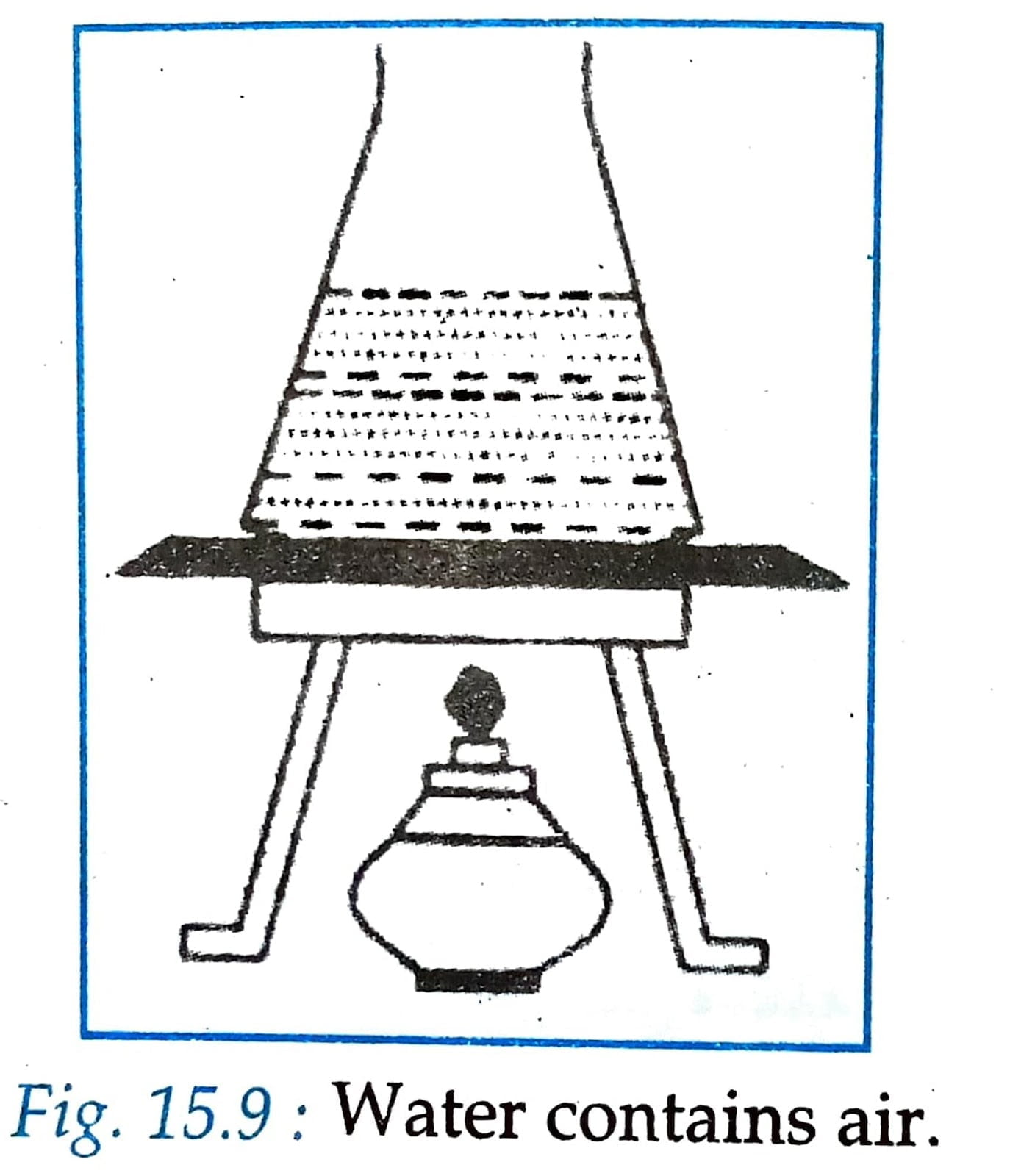
This shows that air is dissolved in water
Q. 5. Why does cotton lump get sunk in water?
Ans: Cotton lump contains air in it. There are various spaces in which air is filled When cotton lump is put into water, air present in the vacant space dissolved in water and cotton lump sank.
Q. 6. The layer of air around the earth is known as………
Ans: The layer of air around the earth is known as atmosphere.
Q. 7. The component of air used by green plants to make their food is……
Ans: Carbon dioxide is needed by green plants to make their food.
Q. 8. List five activities that are possible due to presence of air.
Ans: Activities that are possible due to presence of air are as follows:
(i) Windmill.
(ii) Movement of sailing yachts.
(ii) Flying of aeroplane, birds, etc.
(iv) Dispersal of seeds.
(v) Water Cycle.
Q. 9. How do plants and animals help each other in the exchange of gases in the atmosphere?
Ans. Plants and animals help each other in exchange of gases. They are inter- dependent on each other.
All the require oxygen for their survival. It helps breaking down digested food in the body and releases energy. This process is called respiration. During respiration, carbon dioxide gas is produced.
Plants consume the carbon dioxide gas for preparing their own food and release oxygen. They also use some oxygen for respiration. This oxygen gas is used for animals in their respiration process.
In this way, plants and animals help each other in the exchange of gases in the atmosphere.
SOME OTHER IMPORTANT QUESTIONS FOR EXAMINATION
VERY SHORT ANSWER QUESTIONS
Q. 1. Name the two main gases present in air.
Ans: Two main gases present in air are and Oxygen.
Q. 2. What is the relative proportions of nitrogen and oxygen in air?
Ans: In air, nitrogen and oxygen are present in the ratio 4: 1 by volume.
Q. 3. Which gas in the atmosphere is essential for respiration?
Ans: Oxygen.
Q. 4. Which component of air acts as supporter of combustion?
Ans: Oxygen.
Q. 5. Which gas is given to the patients having breathing problems?
Ans: Oxygen.
Q. 6. What gases are found in the air?
Ans: Air contains nitrogen, oxygen, carbon dioxide and inert gases and water vapours.
Q. 7. Which gas forms the largest part of the air?
Ans: Nitrogen.
Q. 8. Name two processes which consume oxygen from air.
Ans: (i) Respiration by plants and animals.
(ii) Burning of fuels.
Q. 9. Name one process which puts back oxygen into air.
Ans: Photosynthesis by plants.
Q. 10. Name one process which removes carbon dioxide from air.
Ans: Photosynthesis by plants.
Q. 11. Name two which put back carbondioxide into air.
Ans: (i) Respiration by plants and animals.
(ii) Burning of fuels.
Q. 12. Name a gas in air which is used by plants for making food by photosynthesis.
Ans: Carbon Dioxide.
Q. 13. What is the source of oxygen gas in air?
Ans: Photosynthesis by green plants is the source of oxygen gas in air.
Q. 14. What is the percentage of nitrogen in air?
Ans: 78%.
Q. 15. What is the percentage of oxygen in air?
Ans: 20.9%.
Q. 16. What is the source of carbon dioxide in air?
Ans: Respiration by animals and plants and burning of fuels.
Q. 17. Why do we need extra oxygen supply at high altitude?
Ans: Because at high air is thin.
Q. 18. State one biological importance of air dissolved in water.
Ans: Dissolved air helps aquatic animals for breathing.
Q. 19. What is the major part of air that does not support burning?
Ans: Nitrogen.
Q. 20. Why do mostly traffic policemen wear a mask?
Ans: To prevent inhalation of smoke given out by automobiles.
Q. 21. When we boil water, tiny air bubbles come out. Why is it so?
Ans: These are bubbles of air which remain dissolved in water and on heating, this air comes out from the water in the form of air bubbles.
Q. 22. Which gas turns lime water milky?
Ans: Carbon Dioxide.
Q. 23. In an empty room what substance is present around you?
Ans: Air.
Q. 24. Why carbon dioxide is transported in the dissolved form in our blood as compared to oxygen?
Ans: Carbon Dioxide is more soluble in water than oxygen and hence it is mostly transported in the dissolved form in our blood.
Q. 25. A large envelope of air extends upto many kilometres above the surface of the earth. What is this known as?
Ans: Atmosphere.
SHORT ANSWER QUESTIONS
Q. 1. In which form nitrogen is taken up by the plants?
Ans: The nitrogen is taken in the form of nitrates or nitrites, or as organic compounds which have been prepared by bacteria from atmospheric nitrogen.
Q. 2. You must having seen during rainy season, when it rains the animals like earthworms, snakes, snails etc. are commonly seen. Explain, why?
Ans: When it rains, the water gets filled in their dwelling places and pores of the soil. So, they come out in search of air.
Q. 3. How is carbon dioxide gas used to extinguish fire?
Ans: It is because carbon dioxide does not support combustion. When sprayed on burning object, it stops the supply of oxygen and extinguishes fire.
Q. 4. What is the importance of air for living organisms?
Ans: Air is necessary for all living organisms. This because all the living organisms breathe in air. In fact, air is the best medium for the respiratory process. The organisms living on land can get the oxygen required for respiration only from air.
Q. 5. How do animals and plants living in water and soil get oxygen for respiration?
Ans: The animals and plants which live in water use the oxygen dissolved in water for respiration.
The animals which live inside the soil get oxygen for respiration from the air present between the soil particles.
Q. 6. What will happen if the amount of oxygen in the air in increased?
Ans: If the amount of oxygen in the air is increased, the burning of thing will not stop and fire will spread into large area which will be dangerous to humans and for the nature.
O. 7. How can we see upto a long distance after it rains?
Ans: When it rains, the dust in the atmosphere settles down to the ground. This is why we can see upto a long distance just after rain.
Q. 8. Why is nitrogen important for living organisms?
Ans: in air is used for manufacturing food by the nitrogen fixation of atmospheric nitrogen into nitrates which mixes with the soil and plants absorb these as their food. So it is necessary and important for living organisms.
Q. 9. How will you prove that soil contains air in it?
Ans: Take a glass tumbler. Add some soil in it. Then pour some water on the soil slowly. The air-bubbles comes out of the soil. This proves that soil holds air in it.
Q. 10. Why do we see the sky and air clear and clean after rainfall?
Ans: The dust particles which remain suspended in air get loaded and come down on the ground due to rainfall, this is the reason that the sky and the air look clean and clear after rainfall.
Q. 11. Explain why mountaineers carry oxygen cylinders with them?
Ans: As you go up, above the sea-level the atmospheric pressure goes on decreasing and the amount of oxygen also decreases at higher altitude.
Q. 12. Mention two uses of air.
Ans: Uses of Air:
(i) for respiration all organisms need air.
(ii) for burning of any substance air is needed.
SHORT ANSWER QUESTIONS
Q. 1. Write three uses of carbon dioxide.
Ans: Uses of Carbon Dioxide:
(i) It is used as fire extinguisher since it is heavier than air and does not burn.
(ii) Dry ice (solid carbon dioxide) is used as a refrigerant.
(iii) It is used to prepare fizzy drinks like soda-water.
Q. 2. Give one test (or activity) to show the presence of oxygen in air (or atmosphere).
Ans: We take a combustible substance, say a piece of paper and light it with a match stick. The piece of paper starts burning, that is, the piece of paper undergoes combustion. Since the piece of paper burns in air or undergoes combustion in air, therefore, air must contain oxygen in it. This is because oxygen is a supporter of combustion and hence burning or combustion of a substance can take place only if air contains oxygen.
Q. 3. What would happen if plants stop taking carbon dioxide?
Ans: Plants prepare their own food with the help of carbon dioxide. They take carbon dioxide from the atmosphere and consume all the carbon dioxide released by animals through the process of respiration.
If plants stop taking carbon dioxide from the atmosphere, the amount of carbon dioxide increases in the atmosphere and the temperature of atmosphere will increase due to green house effect. Due to this, glacier will melt and there will be flooding on the earth. The nature living organisms will die.
Q. 4. In an activity to study the composition of air, a gas jar stand is placed in a trough of water in which a substance P has been dissolved. A burning candle is fixed on the gas jar and a gas jar is inverted over the burning candle. After some time, the burning candle gets extinguished and water from the trough rises to fill one-fifth of the inverted gas jar. The water rises in the gas jar because the product Q formed by the burning of candle in air gets dissolved in solution of P in water. A gas R is left behind in the inverted gas jar. What are P, Q and R?
Ans: P: Caustic soda (Sodium hydroxide).
Q: Carbon dioxide.
R: Nitrogen.
Q. 5. Which element is an essential constituent of proteins but not of carbohydrates? Can it be utilised by organisms in its elemental form? State the unstable form/forms of this element.
Ans: (i) Nitrogen’ element is one of the essential constituent of proteins but not of carbohydrates.
(ii) No, nitrogen cannot be utilized by organisms in its elemental form.
(iii) The unstable form of nitrogen element is ‘nitrate’ salt.
Q. 6. How can you show that air contains carbon dioxide?
Ans: Take some lime water in a watch glass and keep it for a few hours in open air. A white crust is formed on the upper surface of the lime water. Lime water turns milky due to the presence of carbon dioxide in the air. This shows that air contains carbon dioxide.
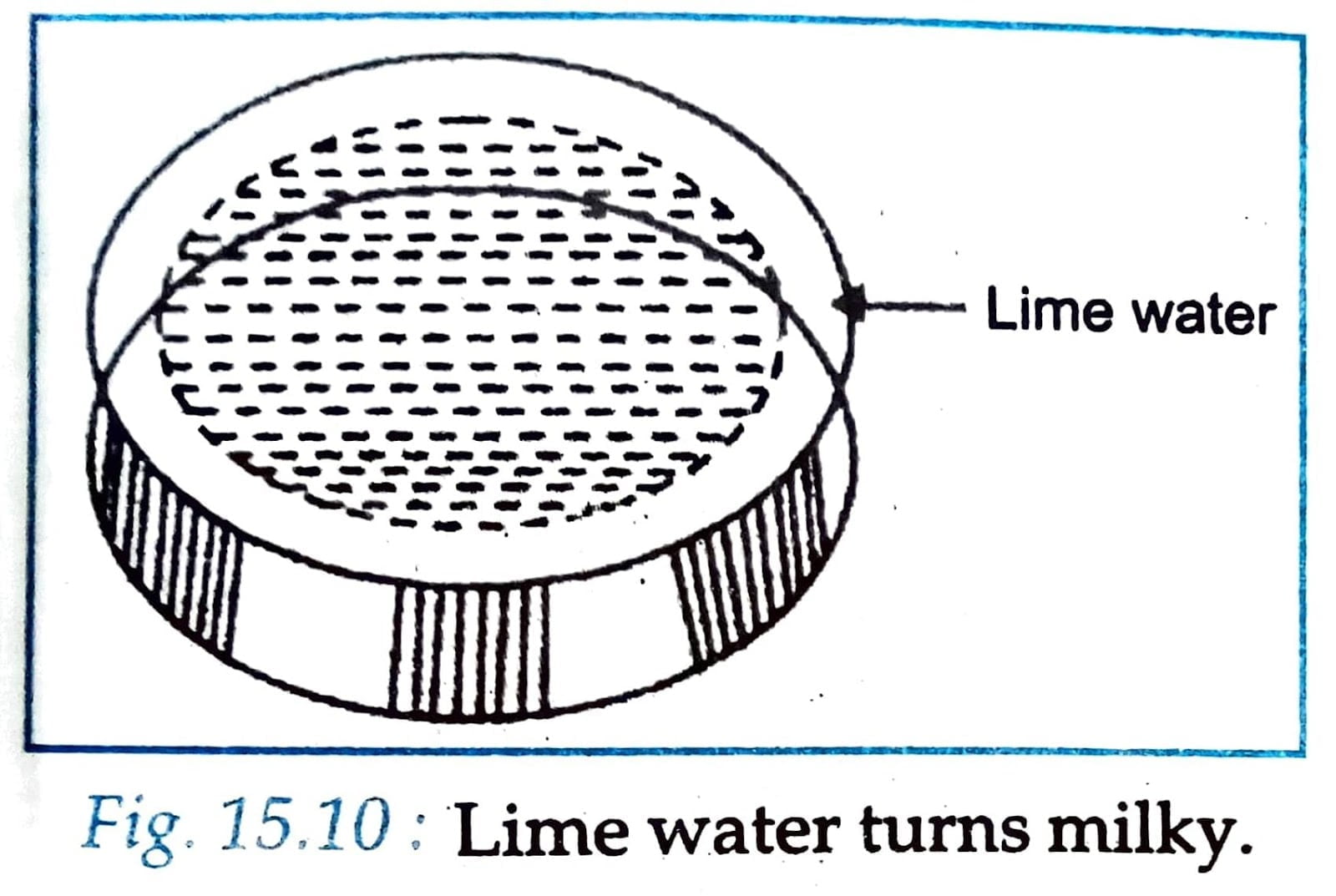
Q. 7. How can you show that air contains water vapour?
Ans: Put some ice blocks in a glass tumbler and keep it in the open air. Drops of water appear on the outer surface of glass tumbler after a few minutes. Air in contact with the
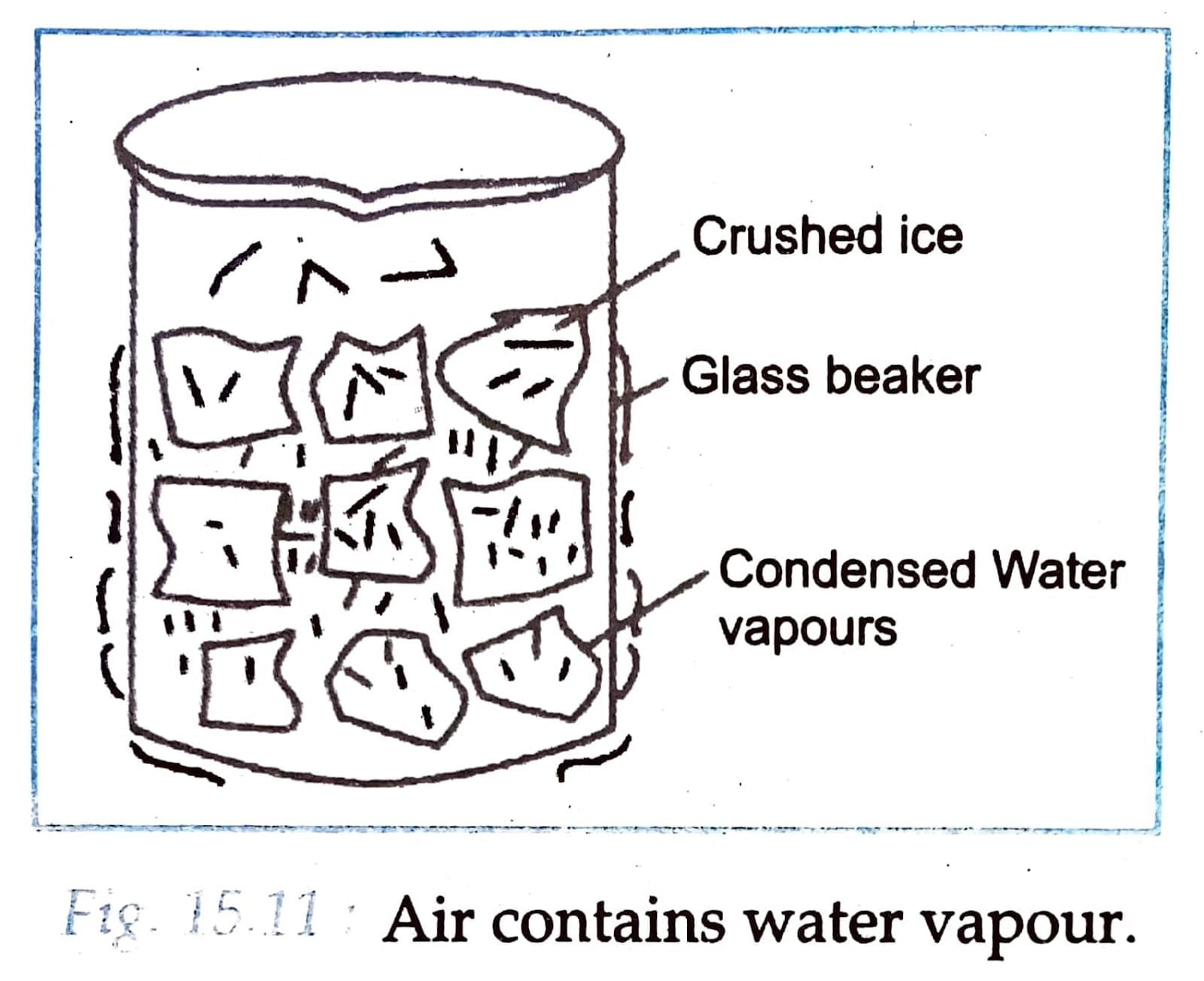
tumbler gets cooled and the water vapour present in it condensed to give drops of water.
Thus, we can see that water is present in air in the form of its vapours.
Q. 8. Describe the balance of oxygen in the air.
Ans: The oxygen in air is used by the organisms present in air, water or soil or on earth for their respiration. During respiration carbon dioxide gas is released to air. But green plants during photosynthesis use carbondioxide of air for preparing food and they release oxygen gas in the air. Thus the balance of oxygen in air is maintained.
Q. 9. Explain respiration in plants.
Ans: Gaseous exchange in plants mainly takes place through the stomata that are present in large number on the leaves. Oxygen diffuses in and carbondioxide diffuses out through these stomata. Respiration is a continuous process, occurring day and night.
Q. 10. Why people love to fly kites near the sea shore?
Ans: In sea shore or coastal regions, during the day, the air above the land gets heated faster and starts As this air rises, a region of low pressure is created and air over the sea moves into the area of low pressure. This movement of air from one region to the other creates winds. During the day, the direction of wind would be from the sea to the land. So, flying kites near sea shore is easy.
Q. 11. In coastal areas, wind current moves from the sea towards the land during day, but during night it moves from land to the sea. Discuss the reason.
Ans: Air above the land gets heated quickly during the day and starts rising. This creates a region of low pressure. As a result, air above sea rushes into the area of low pressure. This movement of air from one region to the other creates winds. During night as the water cools down slowly, the air above water is warmer than the air on land. So, air moves from land to sea creating winds.
Q. 12. What causes winds?
Ans: The air above the land gets heated faster and starts rising. As this air rises, a region of low pressure is created and air over the sea moves into this area of low pressure. This movement of air from one region to other creates winds.
Q. 13. How does fish obtain oxygen for breathing and respiration?
Ans: The fish lives in water which contains dissolved oxygen in it. The fish has special organs of breathing called gills. The fish breathes by taking in water through its mouth and sending it over the gills. When water passes over the gills, the gills extract dissolved oxygen from this water. This oxygen is absorbed by the blood and carried to all the parts of the fish.
Q. 14. What is wind energy? Mention two advantages.
Ans: Blowing air is called wind. Wind possesses kinetic energy. The kinetic energy possessed by wind is called wind energy.
Uses of wind energy are:
(i) wind energy is used to pump the ground water:
(ii) wind energy is used to generate electricity with the help of windmills.
Q. 15. What is respiration? Why does the policeman on the traffic crossing wear a mask?
Ans: Respiration: It is a process in which air rich in oxygen is breathed in by an and air rich in carbon dioxide is breathed out.
The policeman on the traffic crossings wears a mask because of that there is lot of dust and gases on the crossings. The traffic policeman wears such mask to protect him from inhaling poisonous gases and dust particles.
LONG ANSWER QUESTIONS
Q. 1. Describe one test (or activity) to detect the presence of carbon dioxide in air (or atmosphere).
Ans: Lime water is taken in a test tube and air is passed through this lime water for a considerable time by using a delivery tube. The lime water turns milky. This shows the presence of carbon dioxide gas in air. This is because the carbon dioxide gas present in air reacts with lime water to produce a white precipitate of calcium carbonate. The calcium carbonate precipitate produces milkiness in lime water.
Q. 2. State the importance of carbon dioxide in the atmosphere.
Ans: The presence of small amounts of carbon dioxide gas in the atmosphere is essential for the growth and existence of living beings. The desirable proportion of carbon dioxide in the atmosphere is 0.03%. The importance of carbon dioxide in the atmosphere is that
(i) carbon dioxide gas produces green house effect, leading to the heating of earth and its atmosphere, which is essential for our survival.
(ii) Carbon dioxide takes part in the photosynthesis process carried out by green plants to prepare food for plants and animals.
Q. 3. What substance is present in a bottle which appears to be empty? Explain why earthworms come out of the soil only during heavy rains.
Ans: Air is present in a bottle which appears to be empty. The earthworms come out of the soil only during heavy rains. During heavy rains, all the spaces in soil which contained air get filled by rain water leaving no air in the soil for the earthworms to breathe in. Due to this, the earthworms have to come out of the soil to obtain air for respiration.
Q. 4. How does atmosphere act as a blanket?
Ans: The atmosphere mainly contains air and covers the earth like a protective blanket. The air is a bad conductor of heat. So, it keeps the average temperature of Earth fairly steady during the day and even during the course of whole year. The atmosphere prevents the sudden increase in temperature during the day light hours. During night, it slows down the escape of -heat into outer space.
Thus, right amount of heat is received by the earth, which controls and allows the living organisms to exist.
Q. 5. What is atmosphere? Why is atmosphere essential for life on earth? Why do mountaineers carry oxygen cylinders with them while climbing high mountains?
Ans: The envelope of air that surrounds the earth is called atmosphere.
Atmosphere is essential for life on earth. This is because the air of atmosphere provides oxygen gas for breathing by all the living organisms including us. As we go higher up in the atmosphere, the amount of air becomes less and less. The air at the top of very high mountains is so thin that it does not have enough oxygen for the people to breathe properly. So, the mountaineers carry cylinder containing oxygen gas with them. They breathe in oxygen from these cylinders so as to survive on high mountains.
HIGHER ORDER THINKING SKILL QUESTIONS
Q.1. Air is also called ‘breath of life’ why?
Ans: Air is called ‘breath of life because it contains oxygen, which is required by all living organisms for respiration.
Q.2. Why do plants need nitrogen? How do plants obtain nitrogen?
Ans: Plants need nitrogen because it is an essential element for the synthesis of proteins and other compounds. Nitrogen is taken up by the plants in also taken up as organic compounds which have been prepared by bacteria from atmospheric nitrogen.
Q. 3. The two gases A and B together make up about 99% of the air. Both these gases are colorless, tasteless and odorless. Gas A is very reactive whereas gas B is very unreactive. Gas A is necessary for the process of respiration in plants and animals whereas gas B is required by the plants to make proteins.
(a) What is: (i) gas A and (ii) gas B?
Ans: (i) Oxygen.
(ii) Nitrogen.
(b) What is the percentage of (i) gas A and gas B in air?
Ans: (i) 21% (ii) 78%
(c) Which gas, A or B, neither burns nor supports the process of burning?
Ans: Gas B.
(d) Which gas, A or B, is filled in plastic bags containing potato chips to prevent their spoilage?
Ans: Gas B.
Q. 4. The gas X is colorless and odorless having a slightly sour taste which is a minor component of air. It is moderately soluble in water. This gas neither burns nor supports burning. It rather extinguishes a burning fire. If there were no gas X in air, there would be no animals or plants on the earth.
(a) Name the gas X.
Ans: Carbon dioxide.
(b) What is the percentage of gas X in air?
Ans: 0.03%.
(c) State two ways in which gas X is added to air.
Ans: (i) Respiration of animals and plants.
(ii) Burning of fuels by human beings.
(d) Why is gas X very important for the existence of all life?
Ans: Because all the food which animals (including human beings) eat is made from carbon dioxide gas of the air.
Q. 5. What are the various conditions necessary for photosynthesis?
Ans: The various conditions necessary for the process of photosynthesis are:
(i) of carbon dioxide.
(ii) Presence of water.
(iii) Presence of chlorophyll. and
(iv) Presence of sunlight.
Skill Based Questions
Q. 1. Observe the figure on next page and give the answer of the following questions:
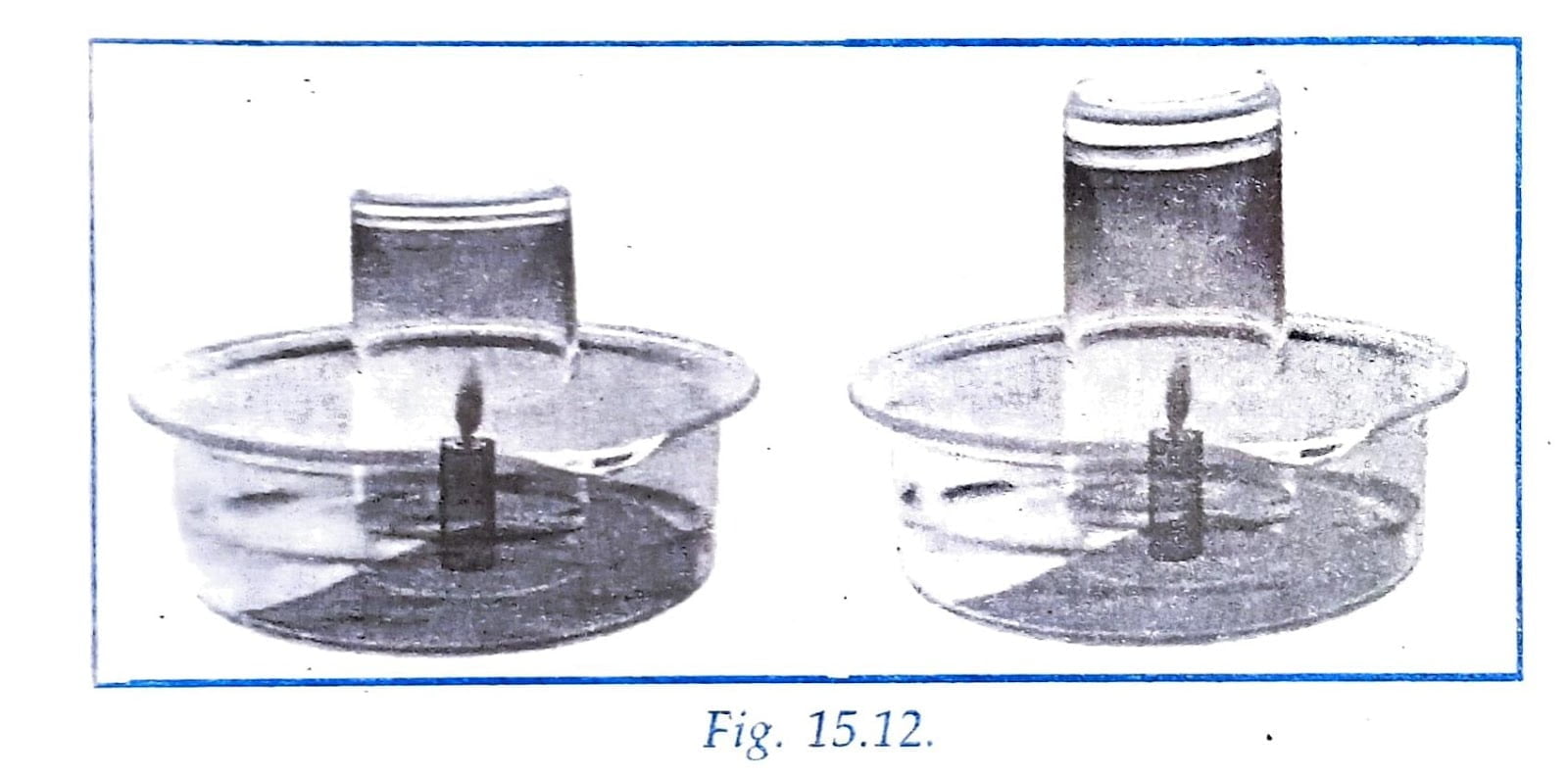
(i) What does this figure show?
Ans: This figure shows that air contains oxygen
(ii) Can burning take place in absence of oxygen?
Ans: Burning cannot take place in the absence of oxygen.
(iii) Write another use of oxygen.
Ans: Oxygen is also required for respiration.
Q. 2. See the following figure and answer the questions that follow:

(i) What does this figure show?
Ans: This figure shows the composition of air.
(ii) Name two gases which mainly form the air.
Ans: Nitrogen and oxygen.
(iii) What is the composition of air?
Ans: Air contains:
(a) Nitrogen.
(b) Oxygen.
(c) Carbon dioxide.
(d) Water vapour.
(e) Other gases like Argon, etc.
FORMATIVE ASSESSMENT
Q. 1. Fill in the following blanks with suitable words:
(i) The envelope of air around the earth is known as ___________.
Ans: Atmosphere.
(ii) The component of air used by green plants to make their food is ___________.
Ans: Carbon dioxide.
(iii) The ___________particles can be seen moving in a beam of sunlight in a dark room.
Ans: Dust.
(iv) Aquatic animals use dissolved ___________in water for respiration.
Ans: Oxygen.
(v) Air helps in the dispersal of __________ and _________ of flowers of several plants.
Ans: Pollen, seeds.
(vi) The component of air which is utilized by the plants in respiration is ___________.
Ans: Oxygen.
(vii) The process of taking in oxygen and giving out carbon dioxide is called ___________.
Ans: Breathing.
(vii) Moving air is called ____________.
Ans: Wind.
(ix) All plants respire with the help of ___________found on the under surface of a leaf.
Ans: Stomata.
(x) ___________is the process of oxidation of food in living cells to form carbondioxide, water and release energy.
Ans: Respiration.
Q. 2. State whether the following statements are true or false:
(i) The composition of air is always exact the same.
Ans: False.
(ii) Nitrogen present in air supports the process of burning.
Ans: False.
(iii) Smoke is produced the burning of fuels.
Ans: True.
(iv) Air is a mixture of gases.
Ans: True.
(v) The percentage of oxygen in air is 78%.
Ans: False.
(vi) Winnowing is more effective in moving air.
Ans: False.
(vii) Fish get the needed oxygen through their gills.
Ans: True.
(viii) to oxygen ratio in the air is 1:4.
Ans: False.
(ix) The air we breathe-in is called inhaled air.
Ans: True.
(x) Burning of fossil is one of the major source of the atmospheric oxygen.
Ans: False.
Q.3. Match the items given in Column A with those in Column B:
| Column A | Column B |
| 1. Nitrogen | (a) Composition of air. |
| 2. Oxygen | (b) Present around us. |
| 3. Carbon dioxide | (c) Burning of fuel. |
| 4. Oxygen | (d) Occupies space. |
| 5. Water | (e) 78% |
| 6. Atmosphere | (f) Generate electricity. |
| 7.Smoke | (g) Supports burning. |
| 8. Air | (h) 0.03% |
| 9. Air | (i) Universal solvent. |
| 10. Wind mill | (j) 20.9% |
Ams:
| Column A | Column B |
| 1. Nitrogen | (e) 78% |
| 2. Oxygen | (j) 20.9% |
| 3. Carbon dioxide | (h) 0.03% |
| 4. Oxygen | (g) Supports burning. |
| 5. Water | (i) Universal solvent. |
| 6. Atmosphere | (a) Composition of air. |
| 7. Smoke | (c) Burning of fuel. |
| 8. Air | (b) Present around us. |
| 9. Air | (d) Occupies space. |
| 10. Wind mill | (f) Generate electricity. |
Q. 4. Write one word for the following:
(i) The process during which energy is produced from the food taken.
Ans: Respiration.
(ii) The organ by which mammals breathe in air.
Ans: Lungs.
(iii) Organisms in which respiration is not easily seen.
Ans: Plants.
(iv) The process by which plants produce carbohydrates and oxygen from carbon dioxide and in the presence of chlorophyll and sunlight.
Ans: Photosynthesis.
(v) Kinetic energy of the moving air.
Ans: Wind energy.
(vi) The envelope of the air surrounding the earth.
Ans: Atmosphere.
(vii) Tiny pores on the leaves by which plants breathe.
Ans: Stomata.
(viii) A gas present in air which helps in respiration and burning.
Ans: Oxygen.
(ix) The mutual dependence of living organisms on one another for their survival.
Ans: Interdependence.
(x) Large volume of gas present in air which does not support burning.
Ans: Nitrogen.
MULTIPLE CHOICE QUESTIONS
(i) Which gas in the atmosphere is essential for respiration?
(a) Oxygen.
(b) Nitrogen.
(c) Carbon dioxide.
(d) Argon.
Ans: (a) Oxygen.
(ii) Air is a mixture of:
(a) Oxygen and nitrogen.
(b) Water vapour and carbon dioxide.
(c) Dust and smoke.
(d) All of the above.
Ans: (d) All of the above.
(iii) The component of air which is utilized by the plants in respiration is:
(a) Nitrogen.
(b) Carbon dioxide.
(c) Oxygen.
(d) Water vapour.
Ans: (c) Oxygen.
(iv) In an activity to show that air is mainly a mixture of two gases (nitrogen and oxygen), the carbon dioxide produced by the burning of candle in air is absorbed by dissolving a substance Y in water in the trough. The substance X is:
(a) Washing soda.
(b) Baking soda.
(c) Caustic soda.
(d) Soda water.
Ans: (c) Caustic soda.
(v) About one-fifth of ordinary air is:
(a) Nitrogen.
(b) Carbon dioxide.
(c) Water vapour.
(d) Oxygen.
Ans: (d) Oxygen.
(vi) While deep under the sea, a deep sea diver cannot utilizes the oxygen dissolved in sea water for breathing because he does not have:
(a) Thin skin.
(b) Gills.
(c) Stomata.
(d) Breathing tubes.
Ans: (b) Gills.
(vii) Nitrogen is needed by the plants to make:
(a) Fats.
(b) Carbohydrates.
(c) Proteins.
(d) Minerals.
Ans: (c) Proteins.
(viii) The ratio of nitrogen to oxygen in the air is:
(a) 1:4
(b) 4:1
(c) 3:1
(d) 1:2.
Ans: (b) 4: 1.
(ix) The gas present in the air which turns lime water milky is:
(a) Oxygen.
(b) Nitrogen.
(c) Argon.
(b) Carbon dioxide
Ans: (b) Carbon dioxide.
(x) The gas present in the air which helps in burning is:
(a) Oxygen.
(b) Nitrogen.
(c) Carbon dioxide.
(d) None of the above.
Ans: (a) Oxygen.
VALUE BASED QUESTIONS
A group of students of class VI were given the project on ‘respiratory diseases’. Students surveyed and found that many people in cities, workers inhaling particulates had the respiratory problem. The students spread an awareness camp on how to overcome the respiratory problems.
(i) What are the causes of respiratory diseases?
Ans: The small, suspended particulates when inhaled causes respiratory diseases.
(ii) Name two respiratory diseases.
Ans: Two respiratory diseases are asthma and bronchitis.
(iii) What value of students of class VI is displayed in the above act?
Ans: Students of class VI showed the value of group work, leadership quality and responsible citizens.

Hi! my Name is Parimal Roy. I have completed my Bachelor’s degree in Philosophy (B.A.) from Silapathar General College. Currently, I am working as an HR Manager at Dev Library. It is a website that provides study materials for students from Class 3 to 12, including SCERT and NCERT notes. It also offers resources for BA, B.Com, B.Sc, and Computer Science, along with postgraduate notes. Besides study materials, the website has novels, eBooks, health and finance articles, biographies, quotes, and more.



